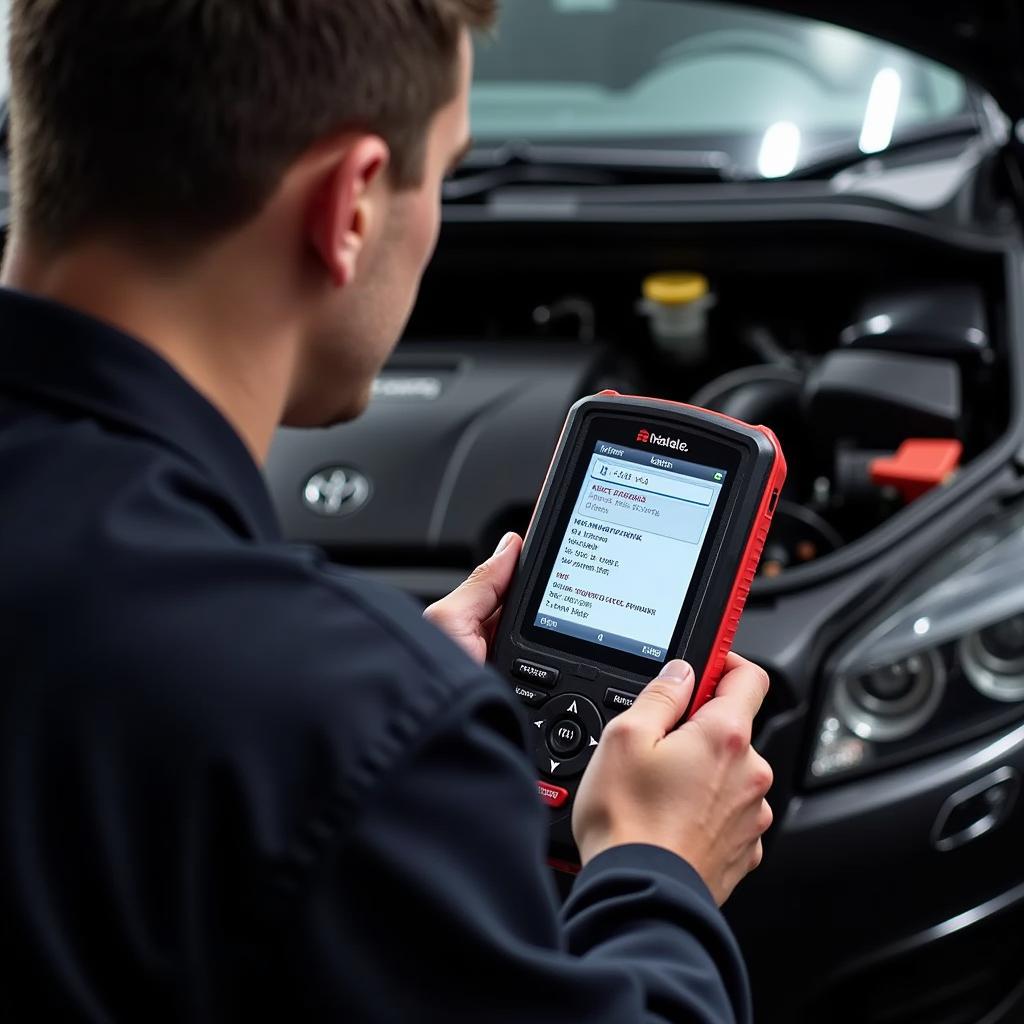A vehicle scan tool has become as essential as any other tool in your garage. Whether you’re a seasoned mechanic or a car enthusiast, a vehicle scan tool, also known as a car diagnostic scanner or OBD2 scanner, can help you understand and potentially fix car problems.
What is a Vehicle Scan Tool?
[image-1|vehicle-scan-tool-connected-to-car|Mechanic connecting a vehicle scan tool to a car’s OBD2 port|A close-up shot of a mechanic’s hand connecting a vehicle scan tool to the OBD2 port located under the dashboard of a car. The tool’s screen displays diagnostic information.]
A vehicle scan tool is an electronic device that connects to your car’s onboard computer, the Engine Control Unit (ECU), through the OBD2 port. This port, usually located under the dashboard on the driver’s side, acts as the communication gateway. By accessing the ECU, the scan tool retrieves and displays diagnostic trouble codes (DTCs), also known as “check engine light codes,” providing insights into your vehicle’s health.
Why Are Vehicle Scan Tools Important?
Vehicle scan tools have revolutionized car repair and maintenance. Here’s why they’re indispensable:
- Early Problem Detection: Scan tools can detect issues even before they manifest as noticeable symptoms, allowing for preventative maintenance and potentially saving you from costly repairs down the road.
- Accurate Diagnosis: Gone are the days of relying solely on guesswork. Vehicle scan tools provide specific DTCs, leading to accurate diagnosis and targeted repairs. This accuracy minimizes the risk of replacing unnecessary parts.
- Enhanced Understanding: By accessing real-time data from various sensors, scan tools offer a comprehensive view of your car’s performance. You can monitor parameters like engine temperature, fuel pressure, and oxygen sensor readings, gaining a deeper understanding of your vehicle’s operation.
- Cost Savings: By empowering you to diagnose and potentially fix some issues yourself, scan tools can save you money on expensive mechanic visits for minor problems.
- Improved Resale Value: Regular use of a scan tool facilitates proactive maintenance, which can translate into a well-documented service history, potentially increasing your car’s resale value.
Types of Vehicle Scan Tools
There are various types of vehicle scan tools, each catering to different needs and budgets:
- Basic Code Readers: These entry-level scanners read and display basic DTCs, offering a starting point for diagnosing check engine light issues.
- OBD2 Scanners: These versatile tools go beyond basic code reading. They can read and clear codes, display live data from various sensors, and even perform some advanced functions like resetting oil light.
- Professional-Grade Scan Tools: Used by mechanics and dealerships, these high-end devices offer comprehensive diagnostic capabilities, including bi-directional control, advanced programming functions, and access to manufacturer-specific data.
How to Choose the Right Vehicle Scan Tool
[image-2|different-types-of-vehicle-scan-tools|Various types of vehicle scan tools for different user levels.|A collection of different vehicle scan tools, ranging from basic code readers to advanced professional-grade scan tools. Each tool is labeled with its type and key features.]
Selecting the right scan tool depends on your needs and technical expertise:
- Car Owners: A basic code reader or an OBD2 scanner is sufficient for reading and clearing codes, checking emissions readiness, and monitoring engine parameters.
- DIY Enthusiasts: An OBD2 scanner with live data streaming, graphing capabilities, and some advanced functions like ABS and airbag system access would be ideal.
- Professional Mechanics: Professional-grade scan tools with bi-directional control, programming functions, and manufacturer-specific coverage are essential.
Using a Vehicle Scan Tool: A Step-by-Step Guide
Using a vehicle scan tool might seem intimidating, but it’s a straightforward process:
-
Locate the OBD2 Port: Usually found under the dashboard on the driver’s side.
-
Connect the Scan Tool: Turn the ignition to the “on” position (without starting the engine) and connect the scan tool to the OBD2 port.
-
Turn on the Scan Tool: Power on the scan tool and follow the on-screen instructions.
-
Read Codes: Select the “Read Codes” function. The scan tool will retrieve and display any stored DTCs.
-
Interpret Codes: Use a reliable online resource or the scan tool’s built-in code library to understand the meaning of each DTC.
-
Clear Codes: After addressing the underlying issue, select “Clear Codes” to erase the DTCs from the vehicle’s memory.
-
Recheck for Codes: After clearing codes, drive the vehicle for a while, then reconnect the scan tool and check if any codes reappear.
“Remember, while a scan tool is a powerful tool, it’s crucial to understand that it doesn’t automatically fix problems. It helps pinpoint the issue, but further diagnosis and repair might be necessary.” – John Smith, Senior Automotive Engineer at ScanToolUS
Common Vehicle Scan Tool Features:
Modern vehicle scan tools offer a range of features, including:
-
Code Reading & Clearing: Reading and erasing DTCs is the primary function of any scan tool.
-
Live Data Streaming: View real-time data from various sensors, such as engine RPM, coolant temperature, and oxygen sensor readings.
-
Freeze Frame Data: Access a snapshot of the vehicle’s sensor readings at the time a DTC was stored, providing context for diagnosis.
-
Component Testing: Some scan tools offer basic component testing capabilities, like activating solenoids or cycling relays.
-
Special Functions: Depending on the model, scan tools might include functions like resetting oil light, TPMS (Tire Pressure Monitoring System) reset, or steering angle sensor calibration.
“Investing in a quality vehicle scan tool is an investment in your car’s longevity and your peace of mind.” – David Lee, Lead Mechanic and Diagnostic Specialist
Conclusion
A vehicle scan tool is an essential tool for anyone who owns, maintains, or repairs cars. From early problem detection to accurate diagnosis, the benefits are undeniable. By understanding the types of scan tools available and learning how to use them effectively, you can take control of your car’s health and potentially save yourself time and money.
Need help choosing the right vehicle scan tool for your needs? Contact the experts at ScanToolUS at +1 (641) 206-8880 or visit our office at 1615 S Laramie Ave, Cicero, IL 60804, USA. We’re here to help you make informed decisions about your car’s maintenance and repair.
Frequently Asked Questions (FAQs)
1. Can I use any scan tool on any car?
Most modern cars (1996 and newer) use the standardized OBD2 system, so most scan tools are compatible. However, some older cars might require manufacturer-specific adapters or tools.
2. What does “check engine light” mean?
The check engine light illuminates when the car’s ECU detects a potential problem within the engine or emissions control system.
3. Will a scan tool tell me exactly what’s wrong with my car?
While a scan tool provides valuable clues in the form of DTCs, it doesn’t always pinpoint the exact issue. Further diagnosis might be needed.
4. Can I fix my car based solely on the scan tool’s information?
It’s not recommended to rely solely on the scan tool for repairs. While it can guide you in the right direction, proper diagnosis often requires mechanical expertise and additional testing.
5. How often should I use a vehicle scan tool?
It’s good practice to scan your car for codes periodically, especially if you notice any unusual performance issues or the check engine light illuminates.
6. Are there any risks associated with using a vehicle scan tool?
Using a reputable scan tool correctly poses minimal risk. However, avoid tampering with settings or functions you don’t understand, as it could potentially affect your car’s performance.
7. Can I update my vehicle scan tool?
Many modern scan tools offer software updates to improve functionality and compatibility with newer car models. Check the manufacturer’s website for available updates.



Pingback: Testing a Used Code Reader Scan Tool: A Buyer's Guide - Car Scan Tool